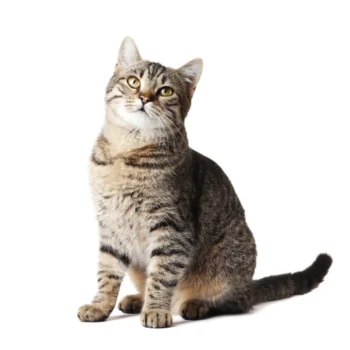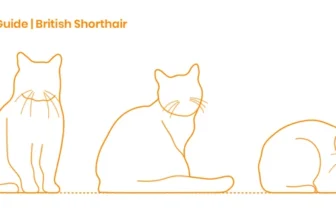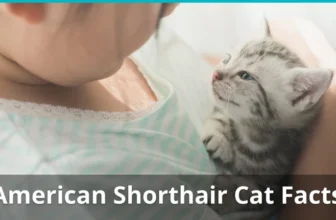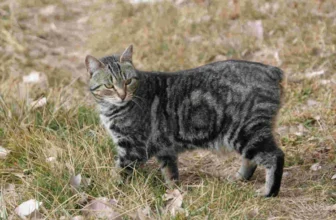Have you ever looked at your American Shorthair cat and wondered about the unique characteristics of their coat? From the intricate patterns of tabbies to the solid shine of black coats, each American Shorthair’s fur tells its own beautiful story. But do you know how these different coat patterns are formed genetically or how to properly groom your cat’s coat? If not, don’t fret! In this article, we’ll explore the fascinating world of American Shorthair coat patterns – from classic tabbies to bi-colors and tri-colors – and help you understand the genetic makeup behind each. We’ll also provide helpful tips for grooming your cat’s coat and maintaining its health and shine. So, let’s dive in and discover the unique beauty of these feline coats!
The Classic Tabby
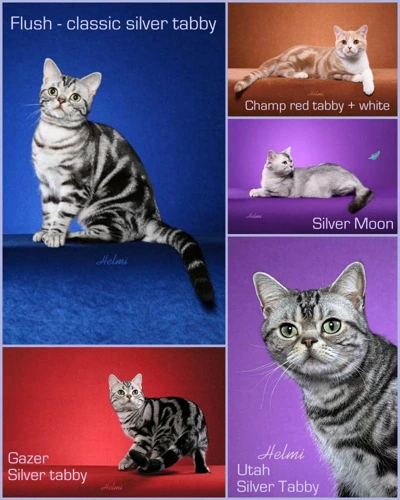
The coat pattern is one of the most prominent features of an American Shorthair cat. It’s always fascinating to observe the beautiful and unique coat markings of these feline cuties. One of the most commonly seen coat patterns is the classic tabby. This coat pattern can vary in appearance, making each American Shorthair with a classic tabby coat unique. Let’s dive deeper into this pattern to uncover its features and what makes it so special for American Shorthair cats. If you’re interested in learning more about the characteristics of American Shorthair cats, check out our article on American Shorthair cat features.
The Mackerel Tabby
The Mackerel Tabby is one of the most common and popular coat patterns of American Shorthair cats. This pattern is characterized by thin, vertical stripes that are evenly spaced apart, resembling the bones of a fish skeleton. The stripes are usually black or dark brown in color and are set against a lighter background. This pattern provides a sleek and slender appearance to the American Shorthair’s muscular build.
Genetics: This pattern is inherited from the agouti gene. The agouti gene is responsible for a cat’s tabby pattern and also plays a crucial role in determining the color of the coat. In Mackerel tabbies, the presence of a high level of the agouti gene creates the distinctive striped pattern.
Personality: American Shorthairs with a Mackerel Tabby pattern are known for their active and playful personalities. They are intelligent and curious creatures who are always on the lookout for something to play with. They are good at problem-solving and are very social animals. Their outgoing nature makes them great family pets and good companions for children.
Care: Generally, American Shorthairs with a Mackerel Tabby pattern are low-maintenance cats in terms of grooming. They do shed, but not excessively, and regular brushing is enough to keep their coat in good condition. However, proper proportions of the cat are very important for the overall health of the cat. You can read more about the importance of shorthair cat proportions by clicking on this blog post. It is also important to check regularly for any eye problems, since American Shorthairs are known to develop certain eye conditions. You can learn more about the eye colors and potential health issues by following this link.
To summarize, the Mackerel Tabby is a beautiful and distinctive pattern that adds to the already impressive looks of American Shorthair cats. This pattern is not only aesthetically pleasing but is also an indicator of a cat’s intelligence and playful personality. Proper care and attention is required to keep these cats healthy and happy.
The Classic Tabby
When it comes to American Shorthair cats, the Classic Tabby pattern is one of the most recognizable. These cats have a coat pattern that features bold, swirling stripes, often resembling the letter “M” on their forehead. The Classic Tabby pattern is known for its intricate swirling patterns with a dark stripe running along the spine.
Distinct Features:
- The coat features stripes that may be thin or thick, dark or light in color.
- The broad stripes circle the legs and tail.
- Bulls-eye patterns are visible on the cat’s flanks, and the underside of the cat is usually lighter in color.
It’s important to note that the Classic Tabby pattern can come in a variety of colors, including silver, brown, blue, and red. This pattern is often seen in American Shorthairs and is a hallmark of the breed.
While the Classic Tabby pattern may be eye-catching, it’s not just for show. The swirls and stripes are believed to help camouflage the cat in the wild. This pattern evolved as a way to hide the cat from predators and prey alike.
If you’re considering bringing an American Shorthair with a Classic Tabby pattern into your home, it’s important to note that these cats have a muscular build. They are strong and have powerful legs which make them excellent jumpers. Proper exercise and playtime are critical for keeping these cats happy and healthy. You can read more about the American Shorthair’s muscular build in our related article.
The Patched Tabby
The patched tabby is a coat pattern that features a mixture of colors in a swirling pattern. It is also known as tortoiseshell tabby, tortie tabby, or a torbie. Unlike other tabby patterns, the patched tabby does not have stripes. Instead, the colors blend together to form a fascinating mixture.
Colors: A patched tabby can have a mixture of black, brown, red, and cream. The distribution of colors is not uniform and can vary from cat to cat. Some patched tabbies can even have a more muted color palette, with shades of gray and white.
Pattern: The pattern is a mixture of intermingled colors with no distinguishable stripes. The patches can be large or small and can occur anywhere on the cat’s body, but are most prominent on the head, back, and sides.
Gender: Almost all patched tabbies are female. This is because the gene responsible for the patched tabby pattern is linked to the X chromosome, of which females have two copies. Males only have one X chromosome, so for them to have a patched tabby pattern, a rare genetic mutation must occur.
Temperament: Like other tortoiseshell cats, patched tabbies are known for their spirited personalities. They are usually outgoing, confident, and assertive. They can be feisty and tend to have strong opinions. For this reason, they may not be the best choice for first-time cat owners.
If you have a patched tabby, it’s important to provide them with plenty of enrichment activities to keep them entertained. This can include interactive toys, scratching posts, and access to a safe outdoor space. Regular grooming is also essential to keep their coat in good condition. This can include brushing, bathing, and regular visits to the groomer.
The Spotted Tabby
The Spotted Tabby is one of the most unique coat patterns for American Shorthair cats. It features small or large spots randomly placed on the cat’s fur, giving it a wild and exotic appearance. This coat pattern is uncommon in the breed, but it is highly sought after by cat enthusiasts.
Spotted Tabby Coat Pattern Chart
| Coat Color | Spot Color |
|---|---|
| Brown | Black or dark brown spots |
| Blue | Navy blue or gray spots |
| Red | Orange or red spots |
| Cream | Light tan or cream spots |
| Silver | Black or dark gray spots |
The Spotted Tabby coat pattern is caused by a specific gene that causes the tabby stripes to break up and form spots. The spots can be small or large and can be evenly or unevenly distributed on the cat’s fur. The Spotted Tabby can come in a variety of colors, including brown, blue, red, cream, and silver.
If you have an American Shorthair with a Spotted Tabby coat pattern, it’s important to groom them regularly to keep their fur healthy and shiny. Use a soft bristle brush to gently remove loose hair and dirt, and consider using a detangling spray or conditioner to help manage any tangles.
Tips for Maintaining Your Spotted Tabby’s Coat
– Use a high-quality, gentle shampoo to avoid stripping the natural oils from your cat’s fur.
– Brush your cat’s fur at least once a week to prevent matting and tangling.
– Pay special attention to the areas around the ears, neck, and tail, as these spots are more prone to matting.
– Consider using a conditioning spray to help detangle your cat’s fur and make it easier to brush.
– Schedule regular grooming appointments with a professional groomer to keep your cat’s coat looking its best.
The Spotted Tabby coat pattern is a unique and exotic trait that can make your American Shorthair stand out from the crowd. With regular grooming and proper care, you can help maintain the health and beauty of your cat’s coat for years to come.
Solid Color Coats
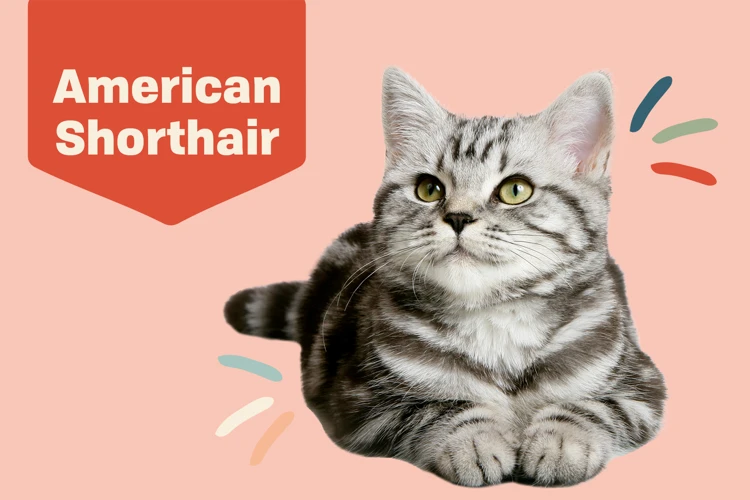
The beauty of American Shorthair cats lies not only in their playful personalities but also in the unique and captivating patterns of their coats. While we’ve already covered the tabby pattern in the previous section, there are other patterns worth exploring. In this section, we’ll be discussing solid color coats, which may not be as flashy as other patterns but still have their own appeal. These coats have a striking simplicity that can be just as eye-catching as more elaborate patterns. Let’s dive into some of the solid color options American Shorthairs can have.
The Black Coat
The black coat is a stunning and timeless look for American Shorthair cats. If you’re lucky enough to have a black-coated American Shorthair as a pet, you’re definitely in for a treat! Here are some things to know about this beautiful coat pattern:
- Black is a dominant gene, which means that if even one of your cat’s parents has a black coat, your cat will likely inherit the gene as well.
- Despite its dark color, black-coated American Shorthairs may actually have some tabby striping on their fur that is only visible in certain lighting or from certain angles.
- The black coat is often associated with sophistication and elegance.
- While solid color coats like black are less prone to showing dirt and stains than some of the patterned coats, regular grooming is still important to keep your cat’s fur healthy and shiny.
- When grooming your black-coated American Shorthair, be sure to use brushes and products that are specifically designed for dark fur. This will help to keep their coat looking its best.
- One thing to keep in mind: black cats have unfortunately been the victims of superstition and negative stereotypes in some cultures. It’s important to remember that the color of a cat’s fur has absolutely no impact on their personality or temperament!
Whether you’re drawn to the timeless elegance of a black coat or prefer a more colorful coat pattern, there’s a lot to love about American Shorthair cats. With their friendly personalities, easygoing nature, and beautiful coats, it’s no wonder that they’re such beloved pets around the world.
The White Coat
The American Shorthair breed has a variety of solid coat colors, one of which is white. A white coat in cats is caused by a lack of pigmentation, and it is important to note that not all white cats are albino. In fact, true albino cats have red or pink eyes, whereas most white cats have blue or green eyes. Let’s take a closer look at the characteristics of American Shorthairs with white coats.
| Characteristic | Description |
|---|---|
| Fur | American Shorthairs with white coats have short, lustrous fur that feels soft to the touch. They are also low-shedding compared to other cat breeds. |
| Eyes | Most American Shorthairs with white coats have blue or green eyes, although some may have odd eyes (one blue and one green). The cool-toned eyes complement the stark white coat. |
| Skin | White-coated American Shorthairs have pink skin, which is more prone to sunburn and skin cancer. It is essential to protect their skin from direct sunlight. |
| Personality | Personality traits in cats are not necessarily linked to coat color. However, American Shorthairs are known for their friendly and affectionate disposition, and white-coated ones are no exception. |
| Health | White cats are more susceptible to deafness as they have a higher chance of being born with a genetic mutation that affects the development of the inner ear. It is important to have your white-coated American Shorthair’s hearing checked regularly. |
Owning a white-coated American Shorthair can be a visually stunning addition to your family. However, as with any pet, it is crucial to be aware of their unique genetic and health characteristics to ensure their well-being.
The Red Coat
American Shorthair cats with a red coat are often referred to as “orange” or “ginger” cats. This hue is produced by a gene known as the “O gene” which produces pigment in the hair shaft, making it appear red. Here are some fascinating facts about American Shorthair cats with a red coat:
- Red Tabby: One of the most famous American Shorthair cats sporting a red coat was a male named Tigger. His red tabby coat made him famous as he appeared in many movies and TV shows throughout the 1970s and ’80s.
- Males More Common: It is rare for a female American Shorthair to have a red coat compared to males. This is because the gene responsible for red pigmentation is located on the X chromosome. Since females have two X chromosomes, there is a greater chance that one of them will be a gene for a different colored coat, like black or silver.
- Eye Color: American Shorthair cats with red coats can have a variety of eye colors. The most common are green and gold, but some may have blue or even odd eyes where each eye is a different color.
- Red and White Bi-Color: Although rare, American Shorthair cats can also have a bi-color coat of red and white. The red areas on the cat will have the classic tabby pattern, while the white areas will be solid.
- Health Benefits: Did you know that American Shorthair cats with a red coat may have a reduced risk of developing certain health problems? According to a study conducted by the University of California, Davis, red cats are less likely to develop heart disease compared to cats with other coat colors.
American Shorthair cats with a red coat are a beloved and unique addition to any household. Their playful and friendly personalities, coupled with their striking coat color, make them a popular choice among cat enthusiasts.
The Cream Coat
The cream coat is a beautiful and popular coat pattern in American Shorthair cats. Cream-colored cats have a pale, almost ivory-colored coat that can range from very light to a deeper, caramel hue. Here are some interesting facts about the cream coat pattern:
- Genetics: The cream coat is a dilution of the black coat gene. This means that a cat with two copies of the cream gene will have a cream coat, while a cat with one copy will be a carrier of the gene but will not display the cream coat pattern.
- Eye Color: Many cream-colored American Shorthair cats have beautiful, bright blue eyes that really stand out against their pale coat. However, cats with this coat pattern can also have green, gold, or amber eyes.
- Personality: American Shorthairs with cream coats are known for their friendly and affectionate nature. They tend to form close bonds with their owners and enjoy spending time cuddling and being petted.
- Grooming: Cream-colored cats require regular grooming to keep their coat looking healthy and shiny. They can be prone to matting and tangles, so it’s important to brush them regularly. A metal comb and slicker brush can be useful tools for grooming cats with this coat pattern.
The cream coat is a desirable and eye-catching coat pattern that is sure to turn heads. If you’re considering adopting an American Shorthair cat with this coat pattern, be prepared to give them plenty of love and attention, as they are sure to become an integral part of your family.
The Blue Coat
The Blue Coat is a rare color in American Shorthair cats but it’s a beautiful and unique one. It has a soft, bluish-gray color that almost looks like it’s been dusted with powdered sugar. Here are some fascinating facts to help you understand the Blue Coat.
- Genetics: The Blue Coat is a diluted version of the Black Coat. It’s caused by a recessive gene called the dilute gene. When a cat inherits one dilute gene from each parent, it will have a Blue Coat.
- Appearance: The Blue Coat has a consistent blue-gray color all over its body. Its eyes can be green, gold, or copper depending on the individual cat. It can also have a white undercoat and some tabby markings.
- Care: Like all American Shorthairs, the Blue Coat is a low-maintenance breed. Its coat is short and dense, so it doesn’t require much grooming. However, regular brushing can help minimize shedding and keep the coat shiny.
- Personality: The Blue Coat American Shorthair has the same friendly and affectionate personality as other American Shorthairs. They are known for being great family pets and getting along well with children and other animals.
If you’re lucky enough to have a Blue Coat American Shorthair, you have a truly special cat. With its unique coloring and lovable personality, it’s no wonder that they are treasured by their owners.
The Silver Coat
The Silver Coat is a stunning and rare color variation that is highly sought after by enthusiasts of American Shorthair cats. This coat pattern is characterized by a pale, silvery-white fur that is tipped with black, giving the cat a distinguished, shimmering look.
Here are some interesting facts about the Silver Coat:
- Genetic Mutation: The Silver Coat is the result of a genetic mutation that affects the production of the black pigment in the fur. This mutation is relatively rare and is only seen in a small percentage of American Shorthair cats.
- Chinchilla Silver: There are two variations of the Silver Coat known to exist – the Chinchilla Silver and the Shaded Silver. The Chinchilla Silver is lighter and more uniform in color, with just the tips of the fur being black. This creates a sparkling, almost frosted appearance which is highly prized by breeders.
- Shaded Silver: The Shaded Silver, on the other hand, has more black on the tips of the fur which creates a darker, more defined pattern on the cat’s coat. This variation is less favored by breeders and enthusiasts but is still highly prized due to its rarity.
- Grooming: Grooming a Silver Coat can be quite challenging due to the delicacy of the fur. Regular grooming with a fine-toothed comb and a soft-bristled brush is necessary to prevent matting and preserve the coat’s luster.
- Personality: American Shorthairs with Silver Coats are known to have a somewhat reserved and sophisticated personality. They are often quieter and less demanding than other breeds and can make excellent companions for those who appreciate their independent nature.
If you are lucky enough to own an American Shorthair with a Silver Coat, you already know that they truly are one of a kind. Their rare beauty and unique personality make them a beloved companion for many cat lovers around the world.
Bicolor and Tricolor Coats
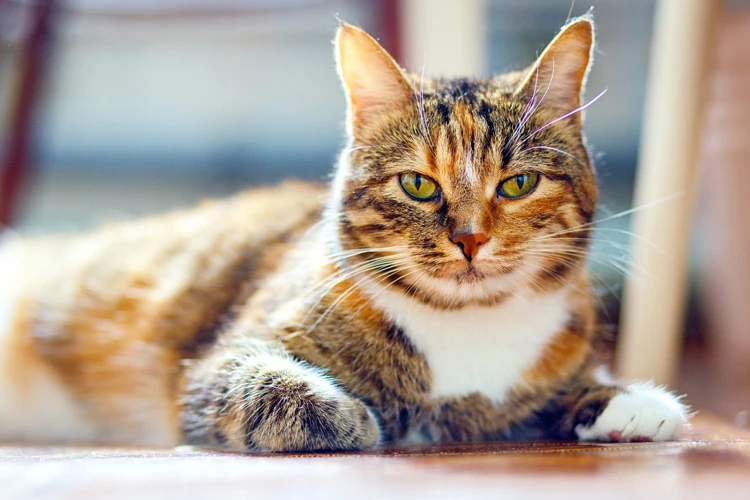
When it comes to the coats of American Shorthair cats, there are a wide variety of patterns to be found. One interesting category is bicolor and tricolor coats, which are often referred to as “parti-color” coats. Bicolor coats feature two distinct colors on the cat’s fur, while tricolor coats typically feature three. These unique combinations can create some truly stunning looks, and understanding how they occur genetically can be especially interesting for cat enthusiasts. In this section, we’ll take a closer look at the different types of bicolor and tricolor coats you might encounter on an American Shorthair, as well as some tips for how to best care for these types of coats.
The Calico Coat
The Calico Coat is a beautiful pattern that is unique to American Shorthair cats. Calico cats have a three-color coat that includes white, black, and orange or red patches. These patches are not evenly distributed and can come in different shapes and sizes, giving each cat a unique look.
Color distribution: The colors on a Calico Coat are not evenly distributed. The white patches can be large or small and can appear anywhere on the cat’s body. The black and orange patches are usually smaller and somewhat irregular in shape. Some calico cats may have more black patches than orange patches, while others may have more orange patches than black patches.
The rarity of the Calico pattern: Calico coats are relatively rare in most cat breeds and are only found in females. This is because the coat pattern is linked to the X chromosome, and females have two X chromosomes, while males have only one. For a male cat to have a calico coat, it must have an extra X chromosome, which is very rare.
Personality traits: Calico cats are known to be very affectionate and loyal to their owners. They also have a reputation for being smart and independent, which can make them a great addition to any household. However, it is important to remember that each cat is unique, and personality traits can vary regardless of coat pattern.
Famous calico cats: There have been many famous calico cats throughout history, including Marzipan, the cat that inspired the famous children’s book “The Three Little Kittens,” and Socks, the cat that lived in the White House during the Clinton Administration.
The Calico Coat is a beautiful and unique pattern that adds to the charm of American Shorthair cats. If you are lucky enough to have a calico cat, be sure to give it the love and attention it deserves.
The Bi-color Coat
The Bi-color Coat is another unique coat pattern that American Shorthair cats can have. This pattern is characterized by two distinct colors on the cat’s fur, with the majority of the fur being one color and the rest being another. Bi-color cats usually have white as one of the colors, which is what sets this pattern apart from the Calico.
How to Recognize
Bi-color American Shorthairs typically have a white coat with patches or spots of another color. It’s important to note that half of the cat’s body doesn’t need to be white – only a significant portion. The other color can be black, gray, cream, red, or even silver. This pattern can manifest in a variety of ways. Some bi-color cats will have a solid white coat with patches of color on the tail and head. Others will have a color dominant coat with white markings on the feet, chest, and face.
History Behind Bi-color Pattern
The bi-color pattern is not isolated to American Shorthairs. In fact, it’s a common feline coat pattern that appears in a variety of breeds. The pattern itself is caused by a genetic mutation, and the details of the genetics involved are still being studied. While it’s hard to say exactly when this pattern was first developed, it’s believed that bi-color cats have been around for as long as domesticated cats have existed.
Grooming Suggestions for Bi-color Coats
Grooming a bi-color American Shorthair’s coat is relatively straightforward. Regular brushing can help keep the cat’s coat healthy and free of tangles. They are not one of the higher-maintenance breeds when it comes to grooming, but it’s important to keep in mind that their white fur may show dirt more easily than other colors. If your bi-color cat has white patches or markings, be sure to keep these areas clean and free of grime.
Personality Traits
While coat pattern does not necessarily dictate the personality of an American Shorthair, bi-color cats are often known for being loving, loyal, and devoted. They are playful and curious and tend to get along well with other cats and even dogs. If you’re looking for a friendly and playful companion, the bi-color American Shorthair may be the perfect fit for you.
To summarize, the bi-color coat pattern is no less fascinating than the others. They have a unique appearance, playful personality, and are low-maintenance when it comes to grooming.
The Van Coat
The Van coat pattern is a type of bi-color pattern in which the cat’s coat is predominantly white, with splashes of color located primarily on the head and tail. This pattern gets its name from the fact that it resembles a traditional Van cat, a rare breed originally from Turkey.
Distinct Characteristics
The Van pattern is distinct from other bi-color patterns because it typically has a large amount of white coat. In fact, in order to be considered a true Van pattern, the cat must have a white coat that covers at least 50% of its body. The remaining color on the cat is typically located on the head and tail, although there may be small patches on the legs or body.
To illustrate the unique qualities of the Van pattern, we can use the following html table:
| White | Color | Pattern | |
|---|---|---|---|
| Van Pattern | 50% or more | Located on head and tail, with possible patches on legs/body | Bi-color |
| Other Bi-color Patterns | Less than 50% | Located in various places on the body | Bi-color |
Popularity
Van pattern American Shorthairs are relatively rare, as the pattern is not as common as the classic tabby or solid color coats. However, the pattern is still highly sought after by cat enthusiasts who appreciate the unique beauty of the Van pattern.
Care and Maintenance
Cats with Van coats require regular grooming, particularly in the colored areas of their fur. These areas may be more prone to tangles and matting, so it’s important to comb the fur regularly to prevent discomfort and skin irritation. specialized brushes and combs for long-haired cats, may be helpful to keep the fur free of tangles.
The Van coat pattern is a rare bi-color pattern where white dominates the coat and color is primarily located on the head and tail. They may require more attention in grooming and care in comparison to other bi-color patterns.
The Harlequin Coat
The Harlequin coat pattern in American Shorthair cats is one of the most unique and visually striking. It is a bicolor pattern that features large, random patches of color on a white background. The colors of the patches can vary widely and include black, red, cream, blue, and silver. This creates a truly stunning and eye-catching appearance that can make any American Shorthair stand out.
What makes the Harlequin coat pattern unique?
Unlike other bicolor patterns, the Harlequin pattern is characterized by its large patches of color on a white background. These patches are asymmetrical, with no specific pattern or shape, making each cat’s coat truly unique. Because of the randomness of the pattern, no two Harlequin American Shorthairs will look exactly alike.
How is the Harlequin coat pattern formed?
The Harlequin coat pattern is a result of genetics, specifically the piebald gene. This gene is responsible for the large patches of white on the cat’s coat, as well as the placement and size of the patches. In a Harlequin cat, the piebald gene is combined with another gene that determines the color of the cat’s coat. This results in the random patches of different colors on a white background.
Caring for your Harlequin American Shorthair’s coat
Maintaining a Harlequin American Shorthair’s coat requires regular grooming, particularly because of the abundance of white fur. Bathing and brushing your cat regularly can help prevent matting and tangling, which can be more noticeable on a bicolor coat. It’s also important to keep your cat’s nails trimmed to prevent any accidental damage to their coat.
To keep your Harlequin American Shorthair’s coat looking its best, consider using high-quality grooming tools such as a slicker brush or a shedding blade. These tools can effectively remove loose fur and prevent matting. Additionally, using a high-quality cat shampoo and conditioner can help keep your cat’s coat soft and shiny.
The Harlequin coat pattern is a unique and visually stunning pattern in American Shorthair cats. While caring for a Harlequin cat’s coat requires some extra effort, their unique appearance is well worth it. By understanding the genetics behind the Harlequin pattern and following some simple grooming tips, you can ensure your Harlequin American Shorthair looks and feels its best.
Understanding the Genetics of Coat Patterns in American Shorthairs
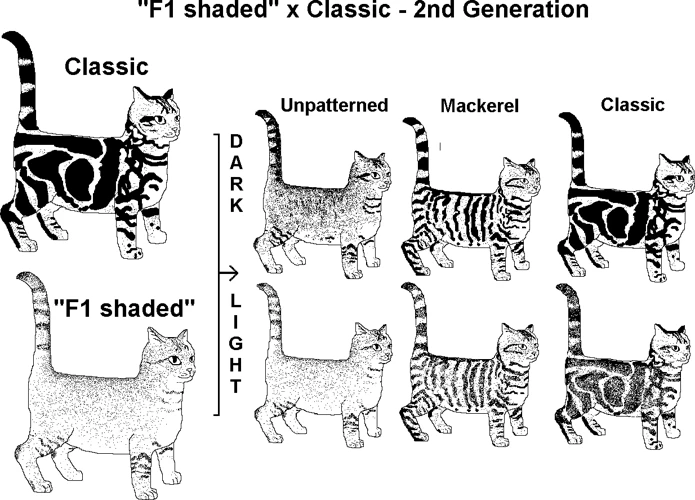
As fascinating as American Shorthair cats are, understanding their genetics can be a perplexing subject. However, delving into the intricacies of their coat patterns can provide a deeper appreciation for these beloved felines. In this section, we will explore the genetics behind the coat patterns found in American Shorthairs, from the classic tabby to the solid colors and the striking bicolor and tricolor patterns. You’ll learn about the genes behind each type of pattern and how they are passed down from generation to generation, giving you a better understanding of just what makes your American Shorthair’s coat so unique.
The Tabby Pattern
The tabby pattern is one of the most common coat patterns found in American Shorthair cats. Tabby cats have distinctive stripes, spots, or swirling patterns on their coat. The tabby pattern is not a specific breed, but rather a description of a coat pattern that can be found in many breeds of cats, including American Shorthairs.
One interesting fact about the tabby pattern is that it is not determined by a single gene. Rather, it is a complex pattern that can be influenced by multiple genes. The tabby pattern can be further divided into four subcategories known as the mackerel tabby, classic tabby, patched tabby, and spotted tabby.
Mackerel Tabby
The mackerel tabby has narrow, curved stripes that run vertically down their body. The stripes can be found on the head, legs, and tail as well. This pattern gives the cat a resemblance to the bones of a fish, hence the name “mackerel”. This pattern is also sometimes referred to as the “fishbone” pattern.
Classic Tabby
The classic tabby, also known as the blotched tabby, is known for its bold, swirling patterns. The patterns feature wide stripes that often form a swirling pattern on the cat’s sides. The classic tabby also has a distinctive “M” pattern on its forehead.
Patched Tabby
The patched tabby, also known as the tortoiseshell tabby, has a unique combination of colors and patterns. These cats have patches of different shades of the tabby pattern, as well as solid color patches. This pattern is more commonly seen in female cats because of the way the genes for coat color are passed down.
Spotted Tabby
The spotted tabby has spots instead of stripes. These spots can be either small or large, and can be found all over the cat’s coat. The spotted tabby can also have a marbled pattern, with the spots blending together in a marbled effect.
Tabby cats are loved for their unique and beautiful coat patterns. Whether your American Shorthair has a mackerel, classic, patched, or spotted tabby pattern, their coat adds to their charm and personality.
The Solid Color Coat Pattern
Solid color coat patterns in American Shorthair cats refer to those cats that have a single uniform color across their entire coat. These can range from a deep black to a light cream color. Although single colors may seem simple compared to other coat patterns, there are still some fascinating aspects to them. Here are some interesting points to keep in mind if you are considering adopting a solid color American Shorthair:
- Genetics: Solid coat colors are the result of a recessive gene that suppresses any tabby markings or other patterns. They are known as “self” colors and can occur in almost any hue. For example, black American Shorthairs have a specially adapted gene that makes their coat black. It is fascinating to think that the genes responsible for coat color have been part of feline evolution for thousands of years!
- Color intensity: The color of a solid coat can vary in intensity and saturation. For example, a cream American Shorthair cat may range from very pale to a rich golden color. Coat color can also be influenced by factors such as age, diet, and exposure to sunlight. It is essential to provide your American Shorthair with optimal nutrition and sun protection to maintain the quality and health of their coat.
- Distinctiveness: While a solid color may seem simple, it can help your American Shorthair stand out from the crowd. Cats with solid coats are often considered classic and elegant. For example, a black American Shorthair has a sleek, edgy appearance, while a white American Shorthair looks clean and fresh. If you prefer a minimalist look, a solid color American Shorthair can be an excellent feline companion!
Solid color coat patterns in American Shorthair cats are straightforward and beautiful. With optimal care, your American Shorthair’s coat can shine brightly and add to their overall stunning appearance. It is crucial to remember that each American Shorthair is unique, and their coat can resemble no one else’s. So, if you prefer a simple, elegant cat, one with a solid coat might be the perfect addition to your home!
The Bicolor and Tricolor Coat Patterns
Bicolor and tricolor coat patterns are some of the most unique patterns found in American Shorthair cats. These patterns consist of two or three distinct colors that are clearly separated from each other. The most popular bicolor pattern is the tuxedo pattern, which is characterized by a black and white coat. On the other hand, tricolor cats are commonly known as calicos.
Bicolor Cats:
Bicolor cats have a distinct and eye-catching coat pattern. A typical bicolor cat will have two colors; white and another color, usually black. However, bicolor cats can have a variety of other colors such as red, cream, gray, and even tabby markings.
To understand the bicolor pattern, we can look at the piebald gene. This gene is responsible for the white fur in bicolor cats. The piebald gene can either be dominant or recessive. If the cat inherits a dominant piebald gene, it will have more white fur than the recessive gene. As a result, a bicolor cat with a dominant piebald gene will have mostly white fur with patches of its other color. On the other hand, a bicolor cat with a recessive piebald gene will have less white fur and more patches of the other color.
The tuxedo pattern is a popular and well-known bicolor pattern. It is characterized by a black coat with distinct white markings on the chest, belly, and paws. Some tuxedo cats may also have white spots on their faces and tails.
Tricolor Cats:
Tricolor cats, also known as calicos, are characterized by three distinct colors in their coat. The most common color combination is black, white, and orange. However, tricolor cats can have a variety of different colors such as gray, blue, cream, and even dilute calicos.
Similar to bicolor cats, tricolor cats also inherit the piebald gene. However, the calico pattern is also influenced by the sex of the cat. Calico cats are almost exclusively female. This is because the genes that determine the black and orange coloring are located on the X chromosome. As a result, a female cat with two X chromosomes can inherit both black and orange genes, resulting in a tricolor coat. Male cats, on the other hand, only have one X chromosome and therefore cannot inherit the calico pattern.
Bicolor and tricolor coat patterns are unique and eye-catching. These patterns are the result of specific genes and are influenced by a variety of factors such as sex and inheritance. Understanding the genetics behind these coat patterns can help you appreciate your American Shorthair’s unique and beautiful coat.
Grooming Your American Shorthair’s Coat
As a proud pet owner, you want your American Shorthair cat to look and feel their best, and proper grooming is essential in achieving that goal. While American Shorthairs are known for their low-maintenance coats, regular grooming is still necessary to keep their fur healthy and shiny. In this section of the article, we will delve into the best practices for grooming your American Shorthair’s coat, including the tools and products you will need, and specific techniques for different coat patterns. So, let’s get started on keeping your feline friend looking and feeling their best!
Tools and Products for Grooming Your Cat’s Coat
Grooming your American Shorthair cat’s coat is essential to maintain its health and appearance. Having the right tools and products can make grooming easier and more effective. Here are some tools and products that are recommended for grooming your cat’s coat:
- Brushes: Depending on your cat’s coat type, you may need different types of brushes. For cats with short, smooth coats like the American Shorthair, a rubber brush or bristle brush can be sufficient. For cats with longer, thicker coats, a slicker brush or comb may be needed to remove tangles and mats.
- Shampoos: When bathing your cat, it’s important to use a shampoo that is formulated for cats and pH balanced. Avoid using human shampoos or those with harsh chemicals that can irritate your cat’s skin.
- Conditioners: Using a conditioner after shampooing can help keep your cat’s coat soft and shiny. Look for products specifically made for cats and avoid using human hair conditioners.
- Nail Clippers: Keeping your cat’s nails trimmed is important for their health and to prevent scratching. Use nail clippers made for cats and take care not to cut the quick, which can cause bleeding and pain.
- Ear Cleaner: Proper ear care is important for cats, especially those with floppy ears. Use an ear cleaner made for cats and cotton swabs to gently clean the ears, but be careful not to insert them too far into the ear canal.
- Toothbrush and Toothpaste: Dental hygiene is crucial for cats to prevent gum disease and other oral health issues. Use a toothbrush and toothpaste specially formulated for cats.
Remember to always use gentle and appropriate products when grooming your American Shorthair cat’s coat, and to be patient and gentle when handling them. Regular grooming can help keep your cat healthy and happy.
Regular Grooming Tips and Techniques
Maintaining the coat of your American Shorthair cat is essential for their overall health and well-being. Here are some regular grooming tips and techniques that you can follow:
| Grooming Technique | Description |
|---|---|
| Brushing | Brush your cat’s coat at least once a week to remove any loose fur, debris, and tangles. Use a slicker brush for short-haired cats and a metal comb for long-haired cats. Be gentle and start at the head, moving towards the tail. |
| Bathing | Bathing your cat is not necessary unless they get into something that can’t be removed by brushing. If you do need to give a bath, make sure to use a cat-specific shampoo and rinse thoroughly to avoid skin irritation. Never use human shampoo on your cat. |
| Nail Trimming | Trim your cat’s nails regularly, about every two weeks, to prevent them from getting too long and sharp. Use a cat-specific nail trimmer and be careful not to cut the quick (the pink part of the nail that contains blood vessels and nerves). |
| Ear Cleaning | Check your cat’s ears regularly for any signs of redness, discharge, or odor. If you notice any of these signs or if your cat is scratching their ears excessively, take them to the vet. Use a cat-specific ear cleaner and a cotton ball to clean the outer ear only, never insert anything into the ear canal. |
These regular grooming tips and techniques will help keep your American Shorthair’s coat healthy and shiny, and also give you the opportunity to bond with your furry friend. Remember to always be gentle and patient during the grooming process to ensure a positive experience for both you and your cat.
Grooming Tips for Specific Coat Patterns
Proper grooming is essential for maintaining the health and appearance of your American Shorthair’s coat. Different coat patterns require different grooming techniques and tools to keep them looking their best. Here are some grooming tips for specific coat patterns:
- Mackerel Tabby: The Mackerel tabby pattern features thin, vertical stripes on a lighter background. Regular brushing with a fine-toothed comb will help maintain the integrity of the pattern and prevent matting. Pay extra attention to the areas where the stripes meet to prevent tangles.
- Classic Tabby: The Classic tabby pattern features swirling patterns on a lighter background. Use a rubber brush to remove loose fur and prevent matting. As with the Mackerel tabby, focus on the areas where the pattern overlaps to prevent tangles.
- Patched Tabby: The Patched tabby pattern features random patches of different colors on a lighter background. Regular brushing with a slicker brush will help prevent matting and keep the fur looking smooth. Pay extra attention to the areas where the different colors meet to prevent tangles.
- Spotted Tabby: The Spotted tabby pattern features large spots on a lighter background. Regular brushing with a rubber brush will help prevent matting and maintain the integrity of the spots. Use a fine-toothed comb to gently tease out any tangles.
- Solid Colors: Solid colored coats require regular brushing with a rubber brush to prevent matting and keep the fur looking smooth. Use a slicker brush to remove any loose fur and maintain the shine of the coat.
- Bicolor and Tricolor Coats: Bicolor and Tricolor coats require regular brushing with a slicker brush to prevent matting and maintain the smoothness of the fur. Pay extra attention to the areas where the different colors meet to prevent tangles. Use a rubber brush to remove any loose fur and maintain the shine of the coat.
Remember to always use the appropriate tools and techniques for your cat’s specific coat pattern to ensure a healthy and gorgeous coat.
Conclusion
After learning about the various coat patterns of American Shorthair cats and the genetics behind them, it’s evident that these cats are truly unique. From the elegant solid color coats to the striking bicolor and tricolor patterns, each individual American Shorthair has a distinctive appearance.
Grooming your cat’s coat is also an important aspect of cat care. Regular grooming not only keeps their coat healthy and shiny but also creates a bond between you and your furry friend. It’s essential to use the right tools and products for your cat’s specific coat type, and learning grooming techniques for each coat pattern can make a big difference in maintaining their appearance.
However, it’s crucial to remember that while coat patterns and grooming are important, they are just a small part of what makes a cat truly special. American Shorthair cats are beloved pets for their playfulness, affectionate nature, and unique personalities. Each cat has its own individual quirks and traits that make them stand out from the rest.
So while it’s exciting to learn about the various coat patterns and genetics behind them, it’s essential not to forget the true essence of your American Shorthair cat. They are more than just their coat, and their personality and bond with you are what truly make them a beloved companion. Cherish the moments you have with your American Shorthair and enjoy the uniqueness that they bring to your life.
Frequently Asked Questions
How many coat patterns do American Shorthair cats have?
American Shorthair cats can have a variety of coat patterns, including tabby, solid color, and bicolor/tricolor patterns.
What is the most common coat pattern for American Shorthair cats?
The most common coat pattern for American Shorthair cats is the classic tabby pattern.
Is the coat color of American Shorthair cats linked to their personality?
No, the coat color of American Shorthair cats is not linked to their personality. The personality of a cat is determined by various factors, including genetics, upbringing, and environment.
Can American Shorthair cats have blue eyes?
No, American Shorthair cats cannot have blue eyes. Blue eyes are more commonly seen in breeds like Siamese and Persian cats.
What grooming tools should I use for my American Shorthair’s coat?
You should use a slicker brush, a metal comb, and a shedding blade for grooming your American Shorthair’s coat.
How often should I groom my American Shorthair’s coat?
You should groom your American Shorthair’s coat at least once a week to keep it healthy and shiny.
Can I groom a patchy tabby coat the same way as a mackerel tabby coat?
Yes, you can groom a patchy tabby coat the same way as a mackerel tabby coat since they both have the same basic tabby pattern.
What is the importance of understanding the genetics of coat patterns in American Shorthairs?
Understanding the genetics of coat patterns in American Shorthairs can help breeders produce cats with specific coat patterns. It can also help cat owners understand why their cat looks a certain way.
What is the best way to groom a bicolor coat?
The best way to groom a bicolor coat is to use a slicker brush and a shedding blade. You should also pay extra attention to the white areas of the coat to prevent staining.
Can I use human shampoo to bathe my American Shorthair?
No, you should not use human shampoo to bathe your American Shorthair since it can be too harsh and strip the natural oils from their coat. You should use a cat-specific shampoo instead.

